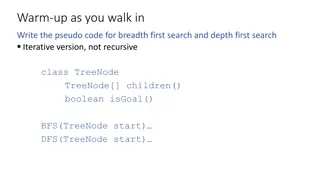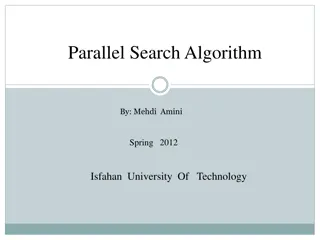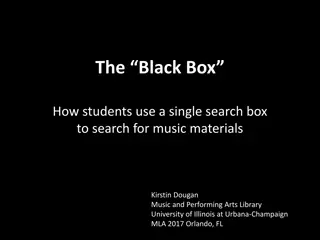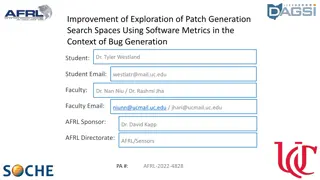Depth-First Search Exploration Techniques
Depth-First Search (DFS) is a graph traversal algorithm that explores all edges leaving a vertex before backtracking. It continues until all reachable vertices are discovered. This process involves classifying edges as tree, back, forward, or cross edges based on the relationship between vertices. DFS Pseudo-codes are provided for implementing the algorithm efficiently.
Download Presentation

Please find below an Image/Link to download the presentation.
The content on the website is provided AS IS for your information and personal use only. It may not be sold, licensed, or shared on other websites without obtaining consent from the author.If you encounter any issues during the download, it is possible that the publisher has removed the file from their server.
You are allowed to download the files provided on this website for personal or commercial use, subject to the condition that they are used lawfully. All files are the property of their respective owners.
The content on the website is provided AS IS for your information and personal use only. It may not be sold, licensed, or shared on other websites without obtaining consent from the author.
E N D
Presentation Transcript
Depth-first search: Explores all edges leaving a given vertex, v, before backtracking to explore edges leaving the vertex from which v was discovered Continues until all vertices reachable from a given source are discovered If the graph still contains undiscovered vertices, choose a new source [v] = u if v was discovered in a search of the adjacency list of u As in BFS, vertices initialized to white, colored gray when discovered, colored back after their adjacency list has been examined d[v] is the timestamp field when v was discovered f[v] is the timestamp field when v was blackened range of timestamps is 1 to 2|V| d[v] < f[v]
Classification of edges: Tree edge connects vertex to its predecessor Back edge connects vertex to an ancestor in the same tree (also self loops in directed graph) Forward edge connects vertex to descendant in the same tree Cross edge: all others If in the same tree, then one vertex cannot be an ancestor of the other
Classification of edge (u->v) by color of v when edge u->v is explored If v is white when u->v is explored then u= (v), u->v is a tree edge and v is discovered In DFS, adj(u) can contain vertices that have already been discovered. If v is gray, u->v is back edge. If v is black, u->v is forward or cross edge
DFS Pseudo codes: DFS(G) for each u V (initialization) do color[u] white, [u] NIL time 0 for each u V (choose a new source) do if color[u] = white then DFS-Visit(u) DFG-Visit(u) (DFS from source u) color[u] gray, time time +1, d[u] time (vertex u discovered) for each v adj[u] do if color[v] = white then [v] u, DFG-Visit(v) color[u] black, f[u] time, time time +1 (finished with vertex u as source)
DFS by hand: unnecessary to perform all steps of pseudo-code Suggested Miller rules on the next slide.
DFS: Fig 22.4 p605 DFS by hand: Enter d(v) in vertex when discovered. Mark the edge from parent with T. If more than one vertex can be discovered from the current vertex, resolve ambiguity by alphabetical order. If no vertices can be discovered from the current vertex add f(v) and begin backtracking. Abandon backtrack if discovery of new vertex is possible. If more than one new source is available, resolve ambiguity by alphabetical order. When all tree edges are marked, label remaining edges as back, forward or cross.
Fig 22.5 p607 Predecessor subgraph G = (V,E ); E = {( [v],v) ; v V and [v] NIL} G contains all the vertices of G; hence, may be multiple trees Where does this DFS violate Miller rules? Do on board with Miller rules. Predecessor subgraph with addition of non-tree edges. May be useful in labeling non-tree edges. After adding non-tree edges, we have the original graph in a different topology Predecessor subgraph showing parenthesis structure
Assignment 19 Ex 22.3-2 text p 610 Perform DFS Use alphabetical order to resolve ambiguities in order of discovery of new vertecies and choosing new sources. Label all edges as tree (T), back (B), forward (F) or cross (C). Mark each vertex with d[v] and f[v]. Draw G
Properties of DFS: G of DFS is a forest of trees, each of which reflects the pattern of recursive calls to DFS-Visit Pattern of discovery and finishing times has parenthesis structure For any 2 vertices u and v, exactly one of the following is true (1) intervals [d[u], f[u]] and [d[v], f[v]] are disjoint neither u nor v is a descendent of the other edges connecting u and v must be cross edges (2) [d[u], f[u]] is contained entirely in [d[v], f[v]] and u is a descendent of v v -> u forward edge u -> v back edge (3) [d[v], f[v]] is contained entirely in [d[u], f[u]] and v is a descendent of u u -> v forward edge v -> u back edge
Simple example of : parenthesis structure (1 (2 3) (4 5) 6) (7 (8 9) (10 11) 12) s r t T 2/3 1/6 7/12 T ? T T ? 10/11 4/5 8/9 v w x
Theorem 22.10: DFS of an undirected graph has no cross edges. The predecessor graph of a DFS of undirected graph is a single tree. One call to DGS-visit will discover all vertices. Hence, no between-tree cross edges. All non-tree edges connect vertices in the same branch. They could have been tree edges if a different path to discover vertices had been taken. Hence, no between-branch cross edges. Non-tree edges in DFS of undirected graph are between related vertices. Text chooses to call then back edges. Do example on board
DFS of undirected graph s s r r t t T 1/12 1/12 2/11 2/11 5/8 5/8 T B T T 3/10 3/10 4/9 4/9 6/7 6/7 T B v v w w x x
White-Path Theorem: Vertex v is a descendant of u in the predecessor forest of a DFS if and only if at the time d[u] when u is discovered, v can be reached from u by a path consisting entirely of white vertices. s r t 1 v w x White-Path theorem says s can be descendent of r by either of 2 paths.
Lemma 22:11 A directed graph is acyclic if and only if a DFS yields no back edges Prove if G has a back edge then G is cyclic: If G has a back edge (x->v) then v is an ancestor of x and (x->v) completes a cycle in G. Prove if G is cyclic then it has a back edge: If G contains cycle c and v is the first vertex discovered in c, then a white path exist to vertex x the last vertex in c By white-path theorem, x is a descendent of v (x->v) must be a back edge
White-Path Theorem: Vertex v is a descendant of u in the predecessor forest of a DFS if and only if at the time d[u] when u is discovered, v can be reached from u by a path consisting entirely of white vertices. s r t 1 v w x s can be descendent of r by White-Path theorem but that will not create a cycle because r->s will be a forward edge
Example illustrating Lemma 22.11 (1 (2 3) (4 5) 6) (7 (8 9) (10 11) 12) s r 1/6 2/3 t T 7/12 T C T T C 10/11 x t 4/5 8/9 v r w s B 1/6 3/4 7/12 T T T T C 8/9 10/11 2/5 v w x (1 (2 (3 4) 5) 6) (7 (8 9) (10 11) 12)
Corollary of the Parenthesis Theorem: Vertex v is a descendant of u in the depth-first forest of G if and only if d[u] < d[v] < f[v] < f[u]
Fig 22.5 p607 Predecessor subgraph G = (V,E ); E = {( [v],v) ; v V and [v] NIL} G contains all the vertices of G; hence, may be multiple trees Predecessor subgraph showing non-tree edges Another way to draw parenthesis structure Are B and F edges correctly labeled? Easy to answer by tree structure.
White-Path Theorem: Vertex v is a descendant of u in the predecessor forest of a DFS if and only if at the time d[u] when u is discovered, v can be reached from u by a path consisting entirely of white vertices. s r T t 2 1 v w x Neither V or W can be a descendent of S.























